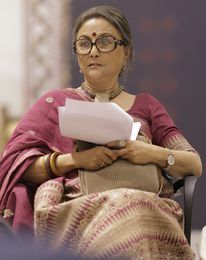Aparna Sen takes the stage showing a video clip of her first film as a child actor. In Satyajit Ray’s Teen Kanya, a film of three stories of three young girls, she plays village belle Pagli in the story ‘Samapti’. A probably 15-year-old Sen wears Bengal’s humble Dhaniakhali sari, sans blouse or petticoat, as she barges into a house on the pretext of chasing a squirrel. The scene involves an arranged-marriage meeting between a city-returned young man and a well-bred young girl. Expectedly, the young man falls in love with the lively Pagli instead.
Sen, 79, is quick to point out how textiles have shaped characters and narratives across cinema. She says, “The history of Bengali cinema will be a gallery of textiles of the state.”
The multiple award-winning actor, screenplay writer and director is speaking in Kolkata at the launch of a book called Textiles from Bengal: A Shared Legacy. The two-day textile symposium coinciding with the launch has been put together by Darshan Mekani Shah, founder and trustee of Weavers Studio Resource Centre.
The Dhaniakhali sari is a symbol of a middle-class but proud Bengal. Named after a village in Hooghly, just 50km from Kolkata, the handloom sari is a simple but everyday staple of the Bengali woman. It is easy to procure and inexpensive, and used to be woven in a dull white with perhaps a small black border. The long-standing chief minister of West Bengal, Mamata Banerjee, a daughter-of-the-soil figure, wears simple variations of the Dhaniakhali like a uniform.
In 36 Chowringhee Lane, Sen’s acclaimed film as director (Shashi Kapoor is producer), young Debashree Roy’s character (Nandita) wears the Dhaniakhali sari by day and a gorgeous red Tangail (from Tangail village, now in Bangladesh, but also adopted across Bengal) sari at night. Jennifer Kendal, who essays the iconic Violet Stoneham, the lonely old English teacher, is dressed in chintz cotton dresses (the English took chintz, or cheent, from India, and sold it to the rest of the world as paisley). A Begum Bahar sari, a cotton and silk Tangail, is also shown in a film clip.
In Goynar Baksho, the terrific 2013 horror comedy Sen directed, young Somalata (played by Konkona Sen Sharma) pawns her late aunt’s jewellery to start a sari shop. There’s a scene with a rap song showcasing the many varied handlooms of Bengal. The aunt (Moushumi Chatterjee) is so attached to her jewellery box, she returns as a ghost.
I have rarely enjoyed a speech on textiles as much as I did with Sen. Not only did she provide a history lesson on Bengal’s several handlooms and what each signified, she cleverly did it with clips from her iconic films.
A lesson to learn for the long list of scholars who were flown in for the symposium—famous names from the Victoria & Albert Museum such as Rosemary Crill, Sonia Ashmore and Avalon Fotheringham, scholar John Gillow (he spoke on the Haji Rumal), and Paola Manfredi (on her expansive knowledge of chikankari).
Each one read from their essays through the days, to a cultured and knowledgeable audience that truly wanted more. The irony is not missed that a group of white researchers came to speak to an Indian audience on Indian textiles, but such is the economics of countries where the western world pays students and researchers to deep dive into topics of interest. In India, and thankfully so, craft and textiles are our everyday quotidian experience. We live and breathe them as we go about our daily tasks.
Our textiles and crafts do not belong to museums and history books alone. We have spent the last decade or so breaking them from the shackles of connoisseurs and scholars. We have made them part of our everyday wardrobe once again, where they belong. And when we are nostalgic about them, we will revisit them in our films.
X@namratazakaria


